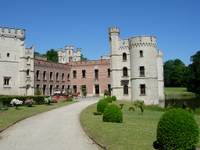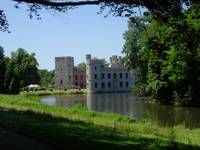And even though you weren’t the least bit interested to hear the following story, I’m going to tell it anyway. This area used to belong to the Royal family and as could be expected, where would they live but in castles. Actually, there used to be two of them, the Castle of Meise destroyed in WWII, Castle of Bouchout still standing, some parts of it dating back to the 14th century, some parts restored. One of the most (in)famous kings of Belgium ever was Leopold II – you may have seen a BBC document a while ago. We may return to Leopold later, but let’s first take a short look at his sister’s life. Princess Charlotte was born in 1840, the only daughter of Belgium’s first king Leopold I. She has been described both beautiful and intelligent (she learned to read before she was three years old), so it was no wonder that there were suitors forming a queue when she grew up. Already at the age of 17 Charlotta married the Austrian archiduc Maximilian – who at some point wrote the following about his bride: “She is very clever, which is a bit worrying, but no doubt I will get over that." I wonder whether he ever did.
This wasn’t one of those stories where the prince and princess live happily ever after. The young couple, still formally future Austrian regents, settled in Italy and started building a castle there: the fabulous Miramare
. However, Maximilian’s brother dismissed him, claiming the Austrian throne himself. Maximilian had powerful allies, though. The Mexican monarchists (yes, Mexican!), supported by the French Napoleon III, offered him the throne of Mexico. M. and Charlotta accepted and were crowned the Emperor and Empress of Mexico, and off they sailed. Even in Mexico they led a turbulent life, and only a few years later Maximilian’s regime was endangered. Charlotta returned to Europe to seek support for her husband but all in vain. Maximilian was executed, Charlotta never returned to Mexico but spent the rest of her life mainly in Italy and Belgium, suffering from mental illness and seemingly being hushed away to a recluse existence. The castles in Meise seemed perfect for this purpose. She died in 1927, according to some sources still believing she was the Empress of Mexico.
More
on the
subject
plus Africa museum link
Bouchout castle

from another angle

Kuvat ei ilmeisesti hämänneet ketään, ne oli otettu lähellä Brysseliä viikonlopun aikana. Belgian kansallisen kasvitieteellisen puutarhan alueella Meisessä pidettiin pienimuotoiset puutarha/harrastemessut, ja tottahan sinne oli ittensä tungettava, kun matkaa on alle 30 kilsaa. Jos on yhtään kasveista kiinnostunut, siellä kantsii poiketa ihan mihin vuodenaikaan tahansa. 92 hehtaarin alueelle mahtuu jos minkälaista aluetta ja rakennuksia: on lasiset vanhat kasvihuoneet, jossa esitellään eri ilmastoalueiden biotooppeja, on kasvientutkimuskeskus, jossa tutkitaan ja ylläpidetään harvinaisia kasvilajeja, eikä saa jättää huomiotta yhdessä rakennuksessa olevaa myymälää, josta saa kasvikirjoja vaikka millä kielillä ja krimskramssukamaa kaupanpäälle. Varsinaisen puiston puolella kiemurtelee polku alueelta toiselle – välillä on ihan tiheää metsäaluetta, välillä taas lampia, yrttipuutarhoja, ruusuportteja, bambupöheikköjä ja sitten taas aukeita niittyjä luonnonkasveineen. Eläimistökin on runsasta: olen onnistunut näkemään metsäkauriita, lammikoissa loiskii karppeja, jotka on yhtä isoja kuin pikkuporsaat, ja sit siellä asustaa vielä hanhilaumoja, jotka huolehtii sekä nurmikon leikkaamisesta että sen lisäravinteista (ovat siis kerrassaan kamalia elikoita sotkemaan, bläägh).
Aattelin taas kertoa teille pienen taustajutun, kiinnostaa se teitä eli ei. Kyseinen alue kuului aikoinaan Belgian kuninkaalliselle perheelle, ja tottahan toki siellä piti siis olla linnoja asuttavaksi. Niitä oli parikin kappaletta, mutta Meisen linna tuhoutui toisessa maailmansodassa. Bouchout-niminen pikkulinna on vielä pystyssä, eräät tornit peräisin 1300-luvulta, mutta suurin osa tietysti restauroitu myöhemmin. Olette ehkä nähneet BBC:n dokumentin yhdestä Belgian kuuluisimmasta kuninkaasta, Leopold II:sta. Hänestä ehkä jorisen joskus toiste, mutta tänään aiheena on Leopoldin sisar, prinsessa Charlotte, joka syntyi vuonna 1840. Charlottea on kuvattu kauniiksi ja älykkääksi (oppi kuulemma lukemaankin alle 3-vuotiaana), joten ei ihme että kosijoita oli jonossa hyvissä ajoin. Charlotte naitettiin jo 17-vuotiaana Itävallan arkkiherttua Maximilianille, joka jossain vaiheessa kuvasi morsiotaan seuraavasti: ”She is very clever, which is a bit worrying, but no doubt I will get over that." Epäilen, ettei.
Tästä ei tullut mitään ”elivät onnellisina elämänsä loppuun asti” –stooria. Tässä vaiheessa nuoripari oli vielä virallisesti Itävallan kruununsyrjässä kiinni, vaikka asettuivatkin asumaan Italiaan ja rakennuttivat pikkupikku Miramarin linnan Triesten lähelle. Muutaman vuoden kuluttua Maximilianin veli syrjäytti hänet kruununperimysjärjestyksessä ja rupesi itse huseeraamaan Itävallan hallitsijana. Mutta Maxillapa olikin vahvoja tukijoita. Meksikolaiset (kyllä vain, meksikolaiset!) monarkistit tarjosivat hänelle Meksikon valtaistuinta, minkä projektin tukijana oli myös Ranskan Napoleon III. Itävaltalaisbelgialainen pariskunta hyväksyi tarjouksen, seilasi Meksikoon ja jatkoi tapahtumarikasta elämäänsä siellä. Eipä mennyt kuin muutama vuosi, kun Maximilian joutui epäsuosioon, Charlotta matkusti Eurooppaan etsimään tukijoita, mutta turhaan. Max teloitettiin, Charlotta ei koskaan palannut Meksikoon vaan eli loppuelämänsä lähinnä Italiassa tai Belgiassa, ja eri lähteiden mukaan kärsien eriasteisista mielenterveysongelmista, joita tietysti tuohon aikaan yritettiin hyssytellä ja Charlotta-tätiä piilotella vetoisissa linnoissa kuten esmers Meisessä. Charlotta kuoli vuonna 1927, mahdollisesti edelleen siinä uskossa, että oli Meksikon hallitsijatar.
Lisää
lukemista
aiheesta
ja bonuksena Afrikkamuseolinkki








No comments:
Post a Comment